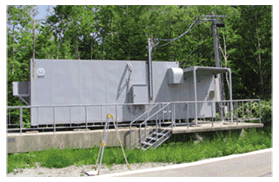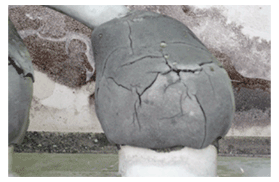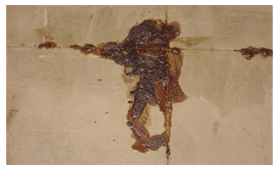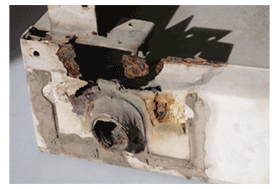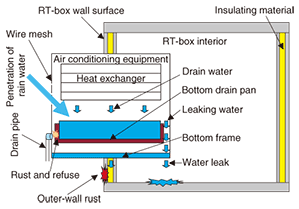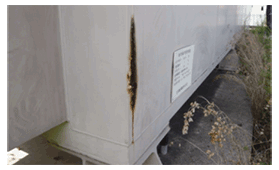 |
|||
|
|
|||
|
Special Feature on Technical Solutions to Real-world Problems Vol. 8, No. 9, pp. 16–18, Sept. 2010. https://doi.org/10.53829/ntr201009sf4 Water Penetration Inspection Methods for Remote Terminal BoxesAbstractThis article describes the problem of water entering remote terminal boxes and corresponding inspection methods.
1. IntroductionThere have been reports of rain water seeping into remote terminal (RT) boxes (Fig. 1) through inferior caulking or caulking cracks at joints between the housing and air conditioning equipment and through cable conduits. Water entering RT boxes can cause insulation faults in telecommunications equipment and accidents like collapsing floors, so checking for water penetration during inspections is an important aspect of RT-box maintenance. The water penetration inspection procedure is described in section 2.
2. Inspection procedureFirst, the exterior of the RT box is visually examined to check for cracks or peeling paint on the outer walls of the housing and for inferior caulking or caulking cracks (Fig. 2) at joints between the housing and air conditioning equipment. Next, an interior inspection is performed to see if rain water can penetrate the housing through joints with air conditioning equipment. In this inspection, lighting inside the housing is turned off to check for light penetrating the interior from the outside. If such light is detected it means that there are openings through which humid air or rain water could enter. In addition, since rain water may also enter cable conduits and penetrate the housing as a result of water pressure, a check for water inside the cable conduits is also performed at this time. A deeper understanding of condensation conditions inside the box can also be obtained by installing a temperature/humidity measuring instrument inside the RT box and measuring relative humidity. There is a high probability that condensation will occur above a relative humidity of 90%. If the relative humidity inside the box jumps significantly on rainy days or during typhoons, rain water is likely to penetrate the RT box.
3. Water penetration due to deterioration of air conditioning componentsHere, we introduce an example of water penetration due to the deterioration of components used in air conditioning equipment. In this example, the water-penetration route could not be identified by the conventional inspection method described above, so it was necessary to develop new inspection items to check for water penetration. There have been reports of foreign matter precipitating in the joints between tiles on the floors of RT boxes (Fig. 3). When this precipitate was gathered up and analyzed, it was found to be polyacrylic acid, which is a hydrolyzed product of the acrylic adhesive used to affix the tiles to the floor. Since moisture is needed for hydrolysis, we can consider that water on the flooring material is a cause of this precipitation. Polyacrylic acid can corrode screws and materials composed of steel. Furthermore, the hydrolysis of acrylic adhesive generates not only polyacrylic acid but also allyl alcohol, which can be harmful to humans if absorbed. To prevent both equipment and workers from being harmed by such substances, we must close off the water penetration routes. A typical water-penetration route inspection is performed as follows.
In this example, the exterior and interior inspections of the RT box for water-penetration routes revealed no problems in terms of housing, caulking, or cable conduits. It was thus inferred that water was probably leaking from air conditioning equipment, so the equipment°«s water-drainage route was inspected. The drainage route for drain water (condensation) generated in the operation of air conditioning equipment, that is, for water collecting in the bottom drain pan, is through a drain pipe that leads to the outside. When the air conditioning equipment was manually operated continuously for about two hours, careful observation of the drain pipe°«s drainage state did not reveal any drain water. Therefore, it was concluded that a problem probably existed with the bottom drain pan. The drainage route was inspected and it was found that water had indeed penetrated the bottom frame underneath the bottom drain pan. A further inspection of the bottom drain pan revealed corrosion in the drain outlet (Fig. 4).
If corrosion in the drain outlet progresses so that rust and refuse accumulate, then condensation on the heat exchanger and rain water blown in by crosswinds can overflow onto the bottom frame underneath the bottom drain pan and thereby penetrate the floor inside the RT box and the insulating material inside the enclosure walls (Fig. 5). Water that penetrates this insulating material can contribute to corrosion inside the enclosure and generate rust in steel in the outer walls and cause peeling of exterior paint (Fig. 6). If the outlet of the bottom drain pan is found to be rusted, repairs should be made using putty or the drain pan should be replaced.
4. ConclusionThough deterioration of RT-box housing and air conditioning components has been reported, RT boxes can continue to operate well if appropriate repairs are performed and degraded components are replaced. Appropriate facility inspections enable faulty elements to be repaired before a critical fault occurs, so RT box maintenance will be increasingly important in the future. |
|||








